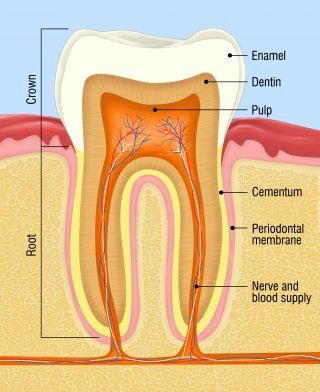Root Canal Basics You Need To Know
This week is Root Canal Awareness Week! Root canals are perhaps the most dreaded, and we suggest misunderstood, dental treatment. We’d love to go through the basics of what a root canal is with you. Root canals can save your natural teeth and you definitely shouldn’t avoid getting one if you need one!
Tooth Anatomy 101

To understand the root canal process, it’s helpful to have a solid understanding of the structure of your teeth. Each tooth has 3 main layers: enamel, dentin, and pulp. Enamel is the hard, clear coating that protects your teeth from bacteria and acid. Dentin makes up the bulk and structure of your teeth, and gives your teeth their color. Pulp is the soft tissue at the core of your teeth that holds nerves and blood vessels. These nerves and blood vessels connect to your nervous and cardiovascular systems through the root canals and tips.
What is a root canal?
A root canal is a treatment for saving a tooth which is infected all the way to the pulp. The procedure removes infected or inflamed tooth pulp, treats the canal with antibiotics, and fills the now empty canals.
Process
- A dentist or endodontist drill a hole through the enamel and dentin to the tooth pulp.
- Using special files and drills, they clear out any infection, remove the tooth pulp, and shape the canals.
- A strong antibiotic treatment is put into the hollow canals, capped with a temporary filling, and left to sit. Usually this is left for a few days to a week, and you should be careful when chewing with this tooth.
- Your dentist or endodontist opens the hole back up and fills the empty canals with a rubber-like material to provide structure and support for the tooth.
- Your dentist will put a crown on the tooth to permanently protect it.
When do I need a root canal?
Your pulp can become infected or inflamed by either injury or cavities. Cavities that are deep or left untreated can reach the pulp and infect the pulp. Since this is where your nerves are, this infection causes intense pain. Sometimes, your tooth pulp may become irritated because of harsh impact (like grinding your teeth) or injury. Since the tooth pulp has blood flow, there is a chance that your body’s immune system can help fight the infection or irritation.
Usually, if your dentist or endodontist thinks the tooth still has a chance of healing itself, they will prescribe antibiotics and wait to see if your tooth works it out. Less intervention and tooth modification is always better if there is no deeper problem. If your dentist or endodontist identifies enough indicators that your tooth pulp won’t recover, they will recommend a root canal procedure instead of pulling the tooth completely.
What are the symptoms of an infection in the tooth pulp?
- Tooth pain, especially pain that decreases with pressure
- Sensitivity to hot and cold, especially sensitivity that lingers
- Swelling in the face and neck
- Painful and tender lymph nodes, bone, and gum tissue
- Sometimes you may not be able to feel any symptoms and may need to rely on professional diagnosis
What happens if I don’t get a root canal?
Getting endodontic treatment is always a choice. We want to inform you of your options, give you our professional opinion, and let you make the choice yourself. If you don’t treat a tooth with dying or infected pulp, it will become more and more painful until all the nerves are dead. There is also a risk that infection from the tooth will spread to other parts of your body. Additionally, untreated infection can eat away at the jawbone muscle and cause an abscess. If you leave the tooth untreated and the tooth dies, it will require extraction. Missing teeth lead to a series of other problems as you can read about here in another blog post.
If you think you may need a root canal, it’s best to see your dentist or endodontist as soon as possible. The earlier the intervention, the more tooth can be saved. Next week we will discuss some exciting advancements in the diagnosis and treatment for root canal procedures that make today’s root canals more efficient and less painful than the treatments even a few years ago.
The post Root Canal Basics You Need To Know appeared first on West One Family Dental.





